Threshold dynamics of a general delayed within-host viral infection model with humoral immunity and two modes of virus transmission
IF 1.3
4区 数学
Q2 MATHEMATICS, APPLIED
引用次数: 1
Abstract
In this paper, a general viral infection model with humoral immunity is investigated. The model describes the interaction of uninfected target cells, infected cells, free viruses and humoral immune response, incorporating two virus transmission modes and intracellular delay. Some reasonable hypothesises are made for the general incidence rates. Through stability analysis of equilibria under these hypothesises, the model exhibits threshold dynamics with respect to the immune-inactivated reproduction rate \begin{document}$ \mathfrak{R}_0 $\end{document} and the immune-activated reproduction rate \begin{document}$ \mathfrak{R}_1 $\end{document} . The theoretical results and corresponding numerical simulations show that the intracellular latency, both of virus-to-cell infection and cell-to-cell infection have direct effects on the global dynamics of the general viral infection model. Our results improve and generalize some known results on within-host virus dynamics.具有体液免疫和两种病毒传播模式的一般延迟宿主病毒感染模型的阈值动力学
In this paper, a general viral infection model with humoral immunity is investigated. The model describes the interaction of uninfected target cells, infected cells, free viruses and humoral immune response, incorporating two virus transmission modes and intracellular delay. Some reasonable hypothesises are made for the general incidence rates. Through stability analysis of equilibria under these hypothesises, the model exhibits threshold dynamics with respect to the immune-inactivated reproduction rate \begin{document}$ \mathfrak{R}_0 $\end{document} and the immune-activated reproduction rate \begin{document}$ \mathfrak{R}_1 $\end{document} . The theoretical results and corresponding numerical simulations show that the intracellular latency, both of virus-to-cell infection and cell-to-cell infection have direct effects on the global dynamics of the general viral infection model. Our results improve and generalize some known results on within-host virus dynamics.
本文章由计算机程序翻译,如有差异,请以英文原文为准。
求助全文
约1分钟内获得全文
求助全文
来源期刊
CiteScore
2.80
自引率
8.30%
发文量
216
审稿时长
6 months
期刊介绍:
Centered around dynamics, DCDS-B is an interdisciplinary journal focusing on the interactions between mathematical modeling, analysis and scientific computations. The mission of the Journal is to bridge mathematics and sciences by publishing research papers that augment the fundamental ways we interpret, model and predict scientific phenomena. The Journal covers a broad range of areas including chemical, engineering, physical and life sciences. A more detailed indication is given by the subject interests of the members of the Editorial Board.

 求助内容:
求助内容: 应助结果提醒方式:
应助结果提醒方式:


